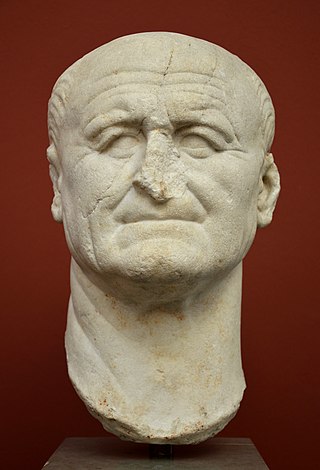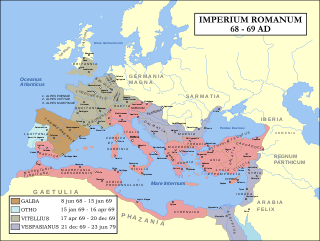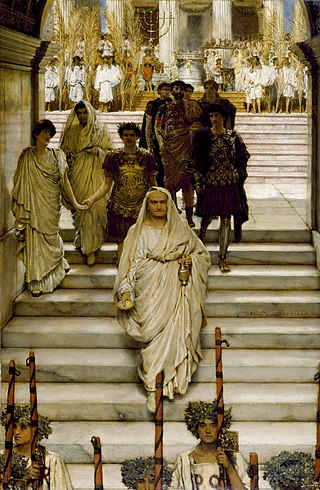Related Research Articles

Vespasian was Roman emperor from 69 to 79. The last emperor to reign in the Year of the Four Emperors, he founded the Flavian dynasty, which ruled the Empire for 27 years. His fiscal reforms and consolidation of the empire brought political stability and a vast building program.

AD 69 (LXIX) was a common year starting on Sunday of the Julian calendar. In the Roman Empire, it was known as the Year of the consulship of Galba and Vinius. The denomination AD 69 for this year has been used since the early medieval period, when the Anno Domini calendar era became the prevalent method in Europe for naming years.

The Year of the Four Emperors, AD 69, was the first civil war of the Roman Empire, during which four emperors ruled in succession: Galba, Otho, Vitellius, and Vespasian. It is considered an important interval, marking the transition from the Julio-Claudians, the first imperial dynasty, to the Flavian dynasty. The period witnessed several rebellions and claimants, with shifting allegiances and widespread turmoil in Rome and the provinces.

The Flavian dynasty, lasting from AD 69 to 96, was the second dynastic line of emperors to rule the Roman Empire following the Julio-Claudians, encompassing the reigns of Vespasian and his two sons, Titus and Domitian. The Flavians rose to power during the civil war of AD 69, known as the Year of the Four Emperors; after Galba and Otho died in quick succession, Vitellius became emperor in mid 69. His claim to the throne was quickly challenged by legions stationed in the eastern provinces, who declared their commander Vespasian emperor in his place. The Second Battle of Bedriacum tilted the balance decisively in favor of the Flavian forces, who entered Rome on 20 December, and the following day, the Roman Senate officially declared Vespasian emperor, thus commencing the Flavian dynasty. Although the dynasty proved to be short-lived, several significant historic, economic and military events took place during their reign.

Marcus Antonius Primus was a senator and general of the Roman Empire.
Aulus Caecina Alienus was a Roman general active during the Year of the Four Emperors.
The Battle of Bedriacum refers to two battles fought during the Year of the Four Emperors near the village of Bedriacum, about 35 kilometers (22 mi) from the town of Cremona in northern Italy. The fighting in fact took place between Bedriacum and Cremona, and the battles are sometimes called "First Cremona" and "Second Cremona".
Lucius Calpurnius Piso Frugi Licinianus (38–69) was a Roman nobleman who lived in the 1st century. His adoption by the Roman emperor Galba on 10 January 69 AD precipitated their joint murder by Otho, who had expected to be adopted instead. Otho then became the second emperor of the Year of the Four Emperors.
Titus Flavius T. f. T. n. Sabinus was a Roman politician and soldier. A native of Reate, he was the elder son of Titus Flavius Sabinus and Vespasia Polla, and brother of the Emperor Vespasian.
Titus Flavius Sabinus was a Roman senator who was active in the first century AD. He was twice consul suffectus, first in the nundinium of April through June of 69 with his brother Gnaeus Arulenus Caelius Sabinus, and again in May and June of 72 as the colleague of Gaius Licinius Mucianus.
Cornelius Fuscus was a Roman general who fought campaigns under the Emperors of the Flavian dynasty. He first distinguished himself as one of Vespasian's most ardent supporters during the civil war of 69 AD, known as the Year of the Four Emperors. Vespasian's son Domitian employed Fuscus as prefect of the Praetorian Guard, a post he held from 81 until his death.
Scribonia Magna, known in modern historical sources as Scribonia Crassi, was a Roman noblewoman. Scribonia was descended from Pompey.
Marcus Licinius Crassus Frugi was a Roman nobleman of consular rank who lived during the Roman Empire. Frugi's mother was an unnamed Roman woman, while his father was consul and governor Marcus Licinius Crassus Frugi. Frugi's adoptive paternal grandfather was consul and general Marcus Licinius Crassus the Younger. Crassus was the grandson of triumvir Marcus Licinius Crassus and the last known direct descendant of his grandfather. He had a daughter called Licinia who married the consul Lucius Calpurnius Piso; their son, Gaius Calpurnius Piso, was a conspirator against the Emperor Nero.
Lucius Salvius Otho Titianus was the elder brother of the Roman Emperor Otho. As a Roman senator, he was consul in the year 52 as the colleague of Faustus Cornelius Sulla Felix, and appointed consul as his brother's colleague for the period from Galba's murder to the end of February. Titianus was given the daily responsibilities of the emperor by Otho when Otho left Rome to halt the advance of Vitellius into Italy. Subsequently, Titianus was appointed generalissimo in charge of the war by Otho and was present at the First Battle of Bedriacum.

The Cancelleria Reliefs are a set of two incomplete bas-reliefs, believed to have been commissioned by the Roman Emperor Domitian. The reliefs originally depicted events from the life and reign of Domitian, but were partially recarved following the accession of emperor Nerva. They are now in the Vatican Museums.
Sulpicia Praetextata was an ancient Roman noblewoman who lived in the Roman Empire in the 1st century.
Marcus Aponius Saturninus was a Senator of Imperial Rome, active in the latter half of the first century AD. His parents, also of senatorial rank, were wealthy and owned property in Egypt. He appears in the Acta Arvalia in the year 57 AD; classicist Ronald Syme suggests that he was made a member of the Arval Brethren due to the influence of Annaeus Seneca. Saturninus is mentioned as being present in 66 for sacrifices on the Capitol with the emperor Nero. Tacitus calls him a consul, but the date of his office is uncertain. He may have been consul in 55; Classical scholar Paul Gallivan at the University of Tasmania has argued that Saturninus was suffect consul between 63 and 66, by which time he was recorded as becoming promagister.

Lucius Calpurnius Piso was a Roman senator active in the first century AD. During the Year of Four Emperors he was governor of Africa and supported Vitellius. After the death of Vitellius he was killed by supporters of Vespasian.
Aulus Marius Celsus was a Roman senator who held several offices in the emperor's service during the first century AD, as well as playing a role in the Year of Four Emperors. He was suffect consul of the nundinium of July to August 69 as the colleague of Gnaeus Arrius Antoninus.
Arrius Varus was a Roman soldier who rose to prominence during the Year of the Four Emperors as a supporter of Vespasian. Varus managed to hold two of the most senior equestrian posts, praetorian prefect and praefectus annonae. What is known about him comes from the writings of the Roman historian Tacitus, who describes him as "an energetic soldier".
References
- 1 2 3 4 Chisholm, Hugh, ed. (1911). . Encyclopædia Britannica . Vol. 18 (11th ed.). Cambridge University Press. p. 954.
- ↑ See Judith B. Ginsberg, "Nero's consular policy", American Journal of Ancient History, 6 (1981), p. 68 n. 55 for a discussion of the year of Mucianus' consulship.
- ↑ Caldwell, Thomas (2015). The Career of Licinius Mucianus (MA). The University of Melbourne, pp. 96-106.
- ↑ Gwyn Morgan, 69 AD: The Year of Four Emperors (Oxford: University Press, 2006), pp. 182-184
- ↑ Morgan, Year of Four Emperors, pp. 186f
- ↑ Morgan, Year of Four Emperors, pp. 223f
- ↑ Morgan, Year of Four Emperors, p. 257
- ↑ Syme, Some Arval Brethren (Oxford: Clarendon Press, 1980), p. 13
- ↑ Paul Gallivan, "The Fasti for A.D. 70–96", Classical Quarterly , 31 (1981), p. 188. The date of one of his three consulates, possibly the first, is unknown.
- ↑ Syme, Some Arval Brethren, p. 15
- ↑ Tacitus, Publius (25 June 2009). The Histories. Penguin. p. 9. ISBN 978-0-140-44964-8.
- ↑ See George Williamson (2005). "Mucianus and a Touch of the Miraculous: Pilgrimage and Tourism in Roman Asia Minor". In Jaś Elsner; Ian Rutherford (eds.). Pilgrimage in Graeco-Roman and Early Christian Antiquity: Seeing the Gods. Oxford: Oxford University Press.